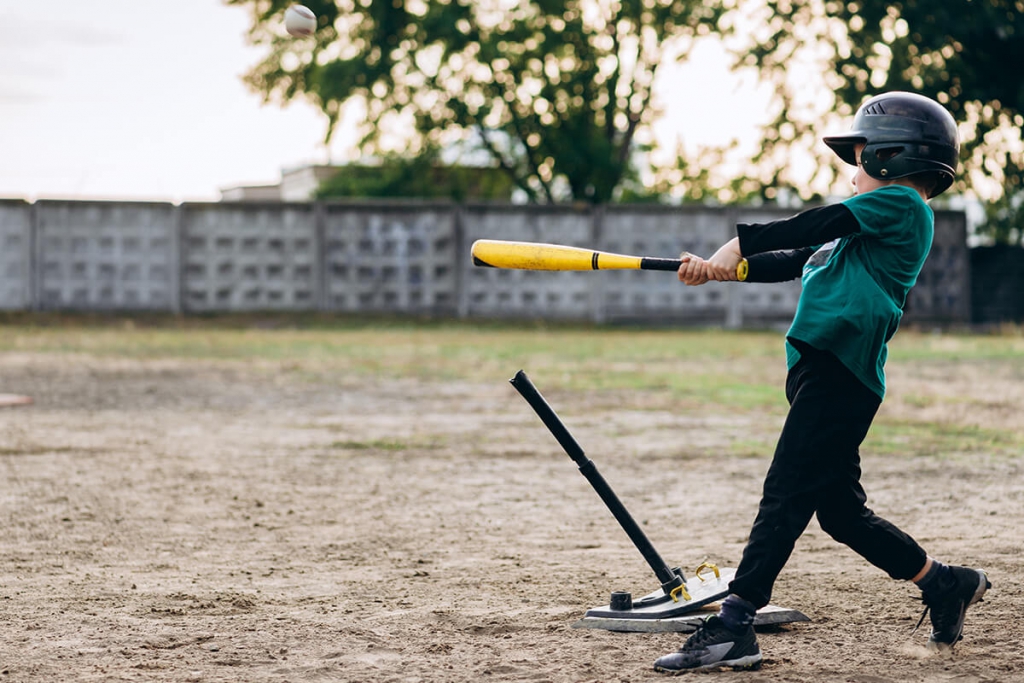The earliest division in most baseball programs is tee-ball. In tee-ball, the batter puts the ball in play by hitting it off a stationary batting tee. Well, “that just ain’t baseball” to some folks, so they are impatient to get the second coming of Mickey Mantle the heck out of there.
Yes, many parents are teed-off at the batting tee. They feel that coaches are holding back their child’s athletic development by using it. “He can hit a pitched ball,” they’ll say. Now that is an interesting disclosure, because it reveals a common misconception about the batting tee – that it amounts to training wheels. In other words, once he can put the bat on a ball in flight he doesn’t need it anymore. Nothing could be further from the truth.
I hate to break it to you, mom and dad, but any kid who is able to feed himself can ‘hit a pitched ball’ with a little practice. It amounts to simple hand/eye coordination and is actually less difficult than learning to walk, which is something he has already mastered. There is a big difference, however, between hitting your friendly tosses in the backyard and hitting pitches from somebody who is trying to get him out. There is also a tremendous difference between just making contact and hitting the ball properly. But first, what about the issue of advancing beyond the tee? When does that day arrive?
In the early 1990s, the Atlanta Braves found themselves locked up in a tight, postseason game. Terry Pendleton, who was on the bench for Atlanta that particular day, anticipated going in as a pinch-hitter in the next half-inning. So he hustled down to the batting cage to hit a few 95 mph pitches from the pitching machine, right? Wrong. The television camera found him patiently ripping baseballs into a net from a batting tee. Terry was the National League batting champion! What was he doing hitting off a batting tee?!
Terry knew what all good hitters know at that level: the tee is one of the best tools for grooving a baseball swing. That’s why Major Leaguers spend days in spring training hitting off one and return to it whenever they develop a problem in their swing. That’s right, mom and dad, your child will never outgrow the batting tee. For that reason, and since it is such an important tool, he’ll need to make friends with it as soon as possible. Let’s begin by establishing why it is so important.
The baseball swing, as opposed to the slow-pitch softball swing, travels from the shoulders down to the hitting zone. The strike zone, you will recall, extends roughly from the letters to the knees. So guess where opposing coaches are going to tell their hurlers to pitch your son. Yep – down by the knees. If he is going to have any success as a hitter in later years, he must begin, early on, to groove a shoulders-down swing. The batting tee is one of the best tools for helping him to accomplish it.
As good as that tool is, however, it can be used improperly and cause problems in his swing. The most common error is to set it too high. Coaches, parents and players generally will do that because it enables Johnny to launch long, lazy fly balls which, let’s face it, are more gratifying than hard line drives and ground balls. The problem is that, in doing so, they are reinforcing some very bad swing habits. Remember, the baseball swing is from the shoulders down, as reinforced by proper use of the tee. Setting it too high encourages the hitter to drop his hands and swing in an upward arc to the baseball. That’s bad; that’s very bad.
Another bad habit, in my opinion, is innocently brought about by the design of the tee itself. Almost always, the base of it is the size and shape of homeplate, with the upright portion jutting up out of its center. Why is that bad? It isn’t, if it is used properly. But almost without fail, a young hitter, at the urging of his coach, will set up relative to the tee at a place where he can extend his arms to make contact. That will result in swinging outside the baseball and/or ‘bailing out’ of the box in later years. We certainly don’t want to encourage that. The solution is to first teach him to maintain proper depth and distance in the batter’s box, relative to home plate. Doing so will ensure that he is able to hit a pitch over the front, outside corner at the knees.
Be sure that he sets up in this manner prior to each swing so he can begin to build the proper muscle memory. When he gets a little older and begins to face live pitching, you should move the tee relative to home plate: inside, outside, out in front, in on his hands, up, down, etc. Encourage him to adjust his swing – not his stance – to the pitch location. That best simulates game conditions. Some batting tees are manufactured to facilitate that type of practice, allowing the upright portion to be repositioned. You might want to invest in one of those.
Yes, if you have a youngster playing baseball, he should own a batting tee and a net. He will use it until his playing days are over. (It’s also a great resource for getting some swings in the garage when the snow is flying.) The game of tee-ball is a tremendous training program for young hitters. My goodness, don’t rush him out of it. On the contrary, make sure that he is getting full benefit from the exercise. There are many resources in your public library, the local bookstore or on-line to help you teach and reinforce proper swing mechanics. Many of them will incorporate drills with the batting tee.
There’s another reason, though, to patiently stay with the tee-ball program and most folks don’t give a single thought to it: defense. That’s right; throwing and fielding. At any given point during a baseball game, you will see one player holding a bat and nine players wearing gloves. Throwing and catching is fundamental to the game of baseball. For that reason, most of the drills you will see a good team running in practice will involve throwing and catching.
Tee-ball is great for working on fielding since the ball is put in play a lot, resulting in far more fielding chances than you will see at higher levels of the game. Think about it – there are no strike outs and, even better, no walks. In the first or second year of kid-pitch, the fielding chances are rare due to the inefficiencies of both the hitters and the pitchers. Why not take advantage of the training down here where there’s no blood on the scoreboard?
So don’t get ‘teed-off’ at the batting tee. Use it to your son’s advantage and use it often. Remember – he’ll never outgrow it, he’ll simply learn to make better use of it as he develops in this difficult game of baseball.
– Bob Totterer






